Results 1 to 3 of 3
Thread Information
Users Browsing this Thread
There are currently 1 users browsing this thread. (0 members and 1 guests)
-
04-22-2015, 12:40 PM #1
Warm Pacific water threatens ecosystem, may intensify drought
An ocean in hot water
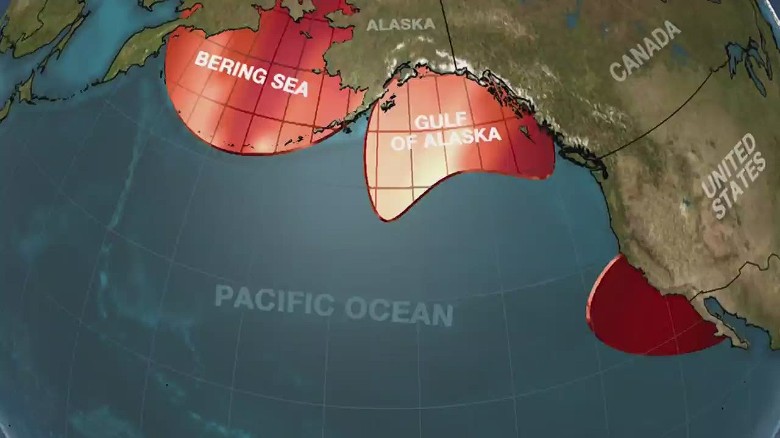
Strange sights as 'blobs' spread
Marine life scatters as huge patches of unusually warm water emerge in the Pacific.
Blob of warm Pacific water threatens ecosystem, may intensify drought
By Steve Almasy, Dave Hennen and Jennifer Gray, CNN
Updated 11:43 AM ET, Wed April 22, 2015
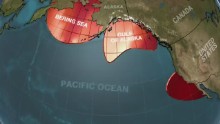 Now Playing
Now Playing
Pacific Ocean's 'Blob' concerns scientists
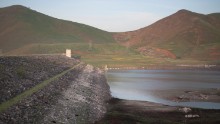
Expert: California drought will force 'major changes'
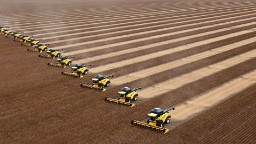
You won't be able to afford your dinner
Story highlights
- Waters in a huge area of the Pacific are running 5.5 degrees warmer than normal
- Marine life that likes cooler water has moved and others that like warm seas are seen in new places
- "The Blob" might be having an effect on rain and snow -- and the West Coast drought
(CNN)Marine life seen swimming in unusual places. Water temperatures warmer than they should be. No snow where there should be feet of it.
Some scientists are saying "The Blob" could be playing a factor.
As monikers go, the blob doesn't sound very worrisome.
But if you're a salmon fisherman in Washington or a California resident hoping to see the end of the drought, the blob could become an enemy of top concern.
A University of Washington climate scientist and his associates have been studying the blob -- a huge area of unusually warm water in the Pacific -- for months.
"In the fall of 2013 and early 2014 we started to notice a big, almost circular mass of water that just didn't cool off as much as it usually did, so by spring of 2014 it was warmer than we had ever seen it for that time of year," said Nick Bond, who works at the Joint Institute for the Study of the Atmosphere and Ocean in Seattle, Washington.
Bond, who gave the blob its name, said it was 1,000 miles long, 1,000 miles wide and 100 yards deep in 2014 -- and it has grown this year.
And it's not the only one; there are two others that emerged in 2014, Nate Mantua of the Southwest Fisheries Science Center -- part of the National Oceanic and Atmospheric Administration (NOAA) -- said in September. One is in the Bering Sea and the other is off the coast of Southern California.
Waters in the blob have been warmer by about 5.5 degrees, a significant rise.
Persistent pressure
A recent set of studies published in Geophysical Research Lettersby Bond's group points to a high-pressure ridge over the West Coast that has calmed ocean waters for two winters. The result was more heat staying in the water because storms didn't kick up and help cool the surface water.
"The warmer temperatures we see now aren't due to more heating, but less winter cooling," a recent news release from the University of Washington announcing the studies said. The university has worked with NOAA on the research.
According to New Scientist magazine, some marine species are exploring the warmer waters, leading some fish to migrate hundreds of miles from their normal habitats.
The magazine cited fisherman and wildlife officials in Alaska who have seen skipjack tuna and thresher sharks.
Pygmy killer whales have been spotted off the coast of Washington.
"I've never seen some of these species here before," Bill Peterson of the Northwest Fisheries Science Center in Seattle told the New Scientist.
And he was worried about the adult Pacific salmon that normally feed on tiny crustaceans and other food sources that are not around in the same numbers off the coast of the Pacific Northwest.
"They had nothing to eat," he told the magazine of last year's conditions in the blob. It appears that food has moved to cooler waters.
In January, Bond told the Chinook Observer in Long Beach, Washington, that his concern is for very young salmon that are still upstream.
"In particular, the year class that would be going to sea next spring," he said.
NOAA said in a news release last month that California sea lion pups have been found extremely underweight and dying, possibly because of an ocean with fewer things to eat.
"We have been seeing emaciated or dehydrated sea lions show up on beaches," Justin Greenman, assistant stranding coordinator for NOAA on the West Coast, told CNN.
The numbers are overwhelming facilities that care for the stranded sea lions, most of whom are pups, local officials said.
Record number of sea lion pups stranded in California
Warmer water, less snow
The blob also is affecting life on land. For the past few years, that persistent ridge of high pressure has kept the West dry and warm, exacerbating the drought in California, Oregon and Washington.
One of the primary problems is small snow accumulation in the mountains.
In early April, officials measured the snowpack in California at a time when it should be the highest. This year it hit an all-time low at 1.4 inches of water content in the snow, just 5% of the annual average. The previous low for April 1 had been 25% in 1977 and 2014. (pdf)
Gov. Jerry Brown, in announcing water restrictions the same day, stood on a patch of dry, brown grass in the Sierra Nevada mountains that is usually blanketed by up to 5 feet of snow.
Low California snowpack ushers mandatory water restrictions
The heat has caused rising air, which can lead to conditions that produce more thunderstorms. With warmer air in California, areas at higher elevations that usually see snow have seen rain instead.
That has led to the lower snowpack and helped compound the drought. The storms also mean more lightning and more wildfires.
And the blob affects people on other areas of the country.
That same persistent jet stream pattern has allowed cold air to spill into much of the Midwest and East.
This stuck pattern has led to the record cold and snow in the Midwest and Northeast over the last two seasons with record snows we have seen in Boston and Detroit, and the most snow we have seen in decades for cities such as Chicago.
Still a mystery
The weather pattern is confusing the experts.
There are some that think it might be a Pacific Decadal Oscillation, a long-lasting El Nino-like pattern in the Pacific.
Dennis Hartmann, a professor of atmospheric science at the University of Washington, doesn't believe the answer is clear.
"I don't think we know ..." he said in the university's news release.
"Maybe it will go away quickly and we won't talk about it anymore, but if it persists for a third year, then we'll know something really unusual is going on."
http://www.cnn.com/2015/04/22/us/pac...lob/index.htmlLast edited by JohnDoe2; 04-22-2015 at 12:47 PM.
NO AMNESTY
Don't reward the criminal actions of millions of illegal aliens by giving them citizenship.
Sign in and post comments here.
Please support our fight against illegal immigration by joining ALIPAC's email alerts here https://eepurl.com/cktGTn
-
04-22-2015, 02:53 PM #2
2 degrees of separation
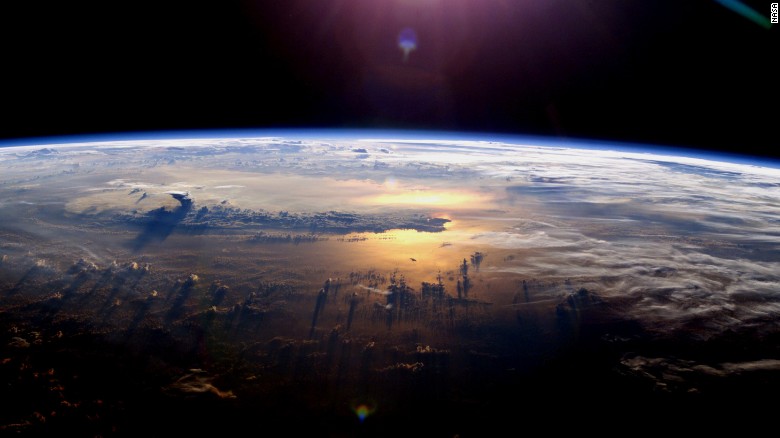
We're at the edge of climate catastrophe
If we warm the world another 2 degrees Celsius, experts say we risk super droughts, extinctions and worse. CNN's John Sutter needs your help deciding which story to tell first...
NO AMNESTY
Don't reward the criminal actions of millions of illegal aliens by giving them citizenship.
Sign in and post comments here.
Please support our fight against illegal immigration by joining ALIPAC's email alerts here https://eepurl.com/cktGTn
-
04-22-2015, 03:02 PM #3
2 degrees: The most important number you've never heard of
By John D. Sutter, CNN
Updated 1:03 PM ET, Wed April 22, 2015
CNN columnist John D. Sutter is spending the rest of the year reporting on a tiny number -- 2 degrees -- that may have a huge impact on the future of the planet. He'd like your help. .
(CNN)tl;dr version: You can vote on the first story I'll report as part of this new series on 2 degrees Celsius -- which is the agreed-upon threshold for dangerous climate change. Go here if you don't see the poll. Thanks!
* * * * *
In 2013, I did something that's a little scary for a journalist.
I asked you to tell me what to cover.
In the two years since, I've traveled the world writing about social justice issues that you selected in an online poll: I went undercover in Southeast Asia to follow the illegal trade in the pangolin, the world's most trafficked mammal; I flew to a lawless town in Alaska to learn why that state has America's highest rate of reported rape; I spent three weeks kayaking (and walking) a river in California that's so dry it fails to reach the sea; and I met a family in Silicon Valley that's living in a garage despite that region's booming wealth from the technology sector.
Those experiences have strengthened my belief in the power of democratic journalism. Editors shouldn't get all the control.
You, the audience, have a vital say, too.
Still, in the two years since I asked for your ideas, I haven't done much, if anything, to address one of the topics you most frequently asked me to cover: climate change.
I'm hoping to make good on your request now.
Starting today, Earth Day, I'm planning to spend the rest of the year writing about one tiny little number -- 2 degrees. It may be the most important number you've never heard of.
Maybe that plan sounds excessive.
(Eight months reporting on one number!?)
But here's why it matters: If we humans warm the world more than 2 degrees Celsius (3.6 Fahrenheit), we greatly up the odds of climate catastrophes.
Think super droughts, rising seas, mass extinctions and acidifying oceans.
We don't want to cross that mark.
Humans never have lived in post-2-degree world, said Carlo Jaeger, chair of the Global Climate Forum, based in Germany, and author of a paper on this history of 2 degrees.
"If we start warming the planet way beyond what humans have ever experienced, God knows what will wait for us," he told me.
Good news, though. If we drastically cut carbon emissions, we can stay below the 2-degree threshold. As part of this series,
I'll be exploring exactly what it would take to do so.
This matters a great deal this year, since the United Nations will gather leaders and policy experts in Paris in December to try to hammer out a new international agreement on climate change. Two degrees will be one useful benchmark to see if the world is on track.
"It's almost kind of like a truth keeping mechanism," said Jennifer Morgan, global director of the climate change program at the World Resources Institute. "It would be hard if it didn't exist to have a sense of whether countries are on track or not."
It's not a perfect yardstick. But it's a reasonable one. Think of it like a speed limit, said Jaeger, the economist in Germany.
Would a 51 mph limit be better than 50? Or maybe it should be 49? The point isn't the exact number, it's the ballpark: 200 mph would certainly be too fast, as he put it, but 20 mph is too slow.
For climate change, the point is we don't know the world will fall into crisis at exactly 2 degrees and not 2.1 or 1.8. But that range is certainly dangerous.
"The way I think of it is like smoking," said Katharine Hayhoe, an atmospheric scientist and director of the Climate Science Center at Texas Tech. "How many cigarettes are too many? I don't know. I have no idea. Nobody has any idea. But we do know the more cigarettes you smoke, the greater the risk."
Two degrees, then, is our most educated estimate. A way to focus attention.
It's incredibly valuable in that respect.
Since the number emerged from a relatively obscure academic paper in the 1970s, it's become widely agreed upon in the international community. In 2009, for example, 114 countriesinitially signed onto the "Copenhagen Accord," a nonbinding agreement that recognizes the "scientific view that the increase in global temperature should be below 2 degrees Celsius."
That level of consensus is rare on this topic.
"If there's one thing the world has agreed upon about climate change it's 2 degrees should be the benchmark," said Jamie Henn, co-founder of 350.org, an advocacy group.
I'll be writing more about the origins of 2 degrees soon -- where this number came from (one guy, turns out, and I chatted with him), how soon we may cross that mark if we don't take action (short answer: 2050), and how much we've warmed the planet since the start of the industrial revolution, in the late 1800s, which is how these temperature increases are usually measured (0.85 degrees).
Right now, though, I'd like to ask you to do something that's scary and exciting.
I want you to vote on the first project I'll report for this series.
All of the options center on one theme: What does a post-2-degree world look like?
I love that question because it -- like all six choices you'll see below -- came from you.
CNN hosted a Facebook chat on Friday, asking our audience to come up with questions for me about climate change or about 2 degrees of warming. Many of you said you wanted to know what a 2-degree world would have in store, in general.
Other folks asked about specific impacts to people and ecosystems if the climate continues to inch toward that dangerous 2-degree mark.
Clay Miller, from Alaska, for example, asked about the Arctic.
Cindy Johnson wanted to know which animals would go extinct first.
Jon Locke was among those curious about farms.
And many of you, including Kayla Helton, from Florida, asked about rising seas. Kelly Dougherty, in particular, wanted to know what would happen to "climate refugees" as the coast vanishes.
http://www.cnn.com/2015/04/21/opinio...ees/index.htmlNO AMNESTY
Don't reward the criminal actions of millions of illegal aliens by giving them citizenship.
Sign in and post comments here.
Please support our fight against illegal immigration by joining ALIPAC's email alerts here https://eepurl.com/cktGTn
Similar Threads
-
‘Unprecedented’ warm blob weather phenomenon creates concerns for shrimp, Pacific whi
By JohnDoe2 in forum Other Topics News and IssuesReplies: 1Last Post: 03-10-2015, 03:50 PM -
Drought -- and neighbors -- press Las Vegas to conserve water
By JohnDoe2 in forum Other Topics News and IssuesReplies: 0Last Post: 04-21-2014, 03:06 PM -
Drought sparks water war in Texas
By JohnDoe2 in forum Other Topics News and IssuesReplies: 0Last Post: 10-04-2012, 09:27 PM -
Battle over water heats up in drought-stricken California
By JohnDoe2 in forum Other Topics News and IssuesReplies: 4Last Post: 06-29-2009, 08:20 PM -
Drought to cut off federal water to Calif. farms
By AirborneSapper7 in forum Other Topics News and IssuesReplies: 2Last Post: 02-21-2009, 08:58 AM


 LinkBack URL
LinkBack URL About LinkBacks
About LinkBacks




 Reply With Quote
Reply With Quote


Watch: Paul, Hawley Torch Mayorkas To His Face On Laken Riley's...
04-19-2024, 02:32 PM in illegal immigration News Stories & Reports